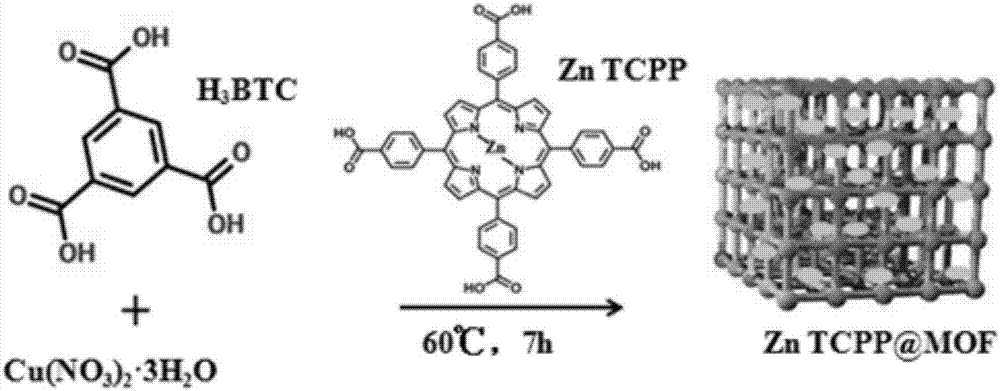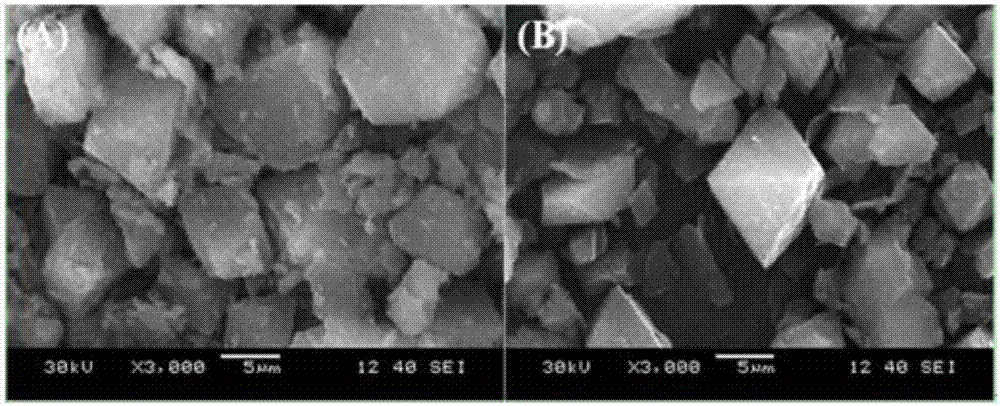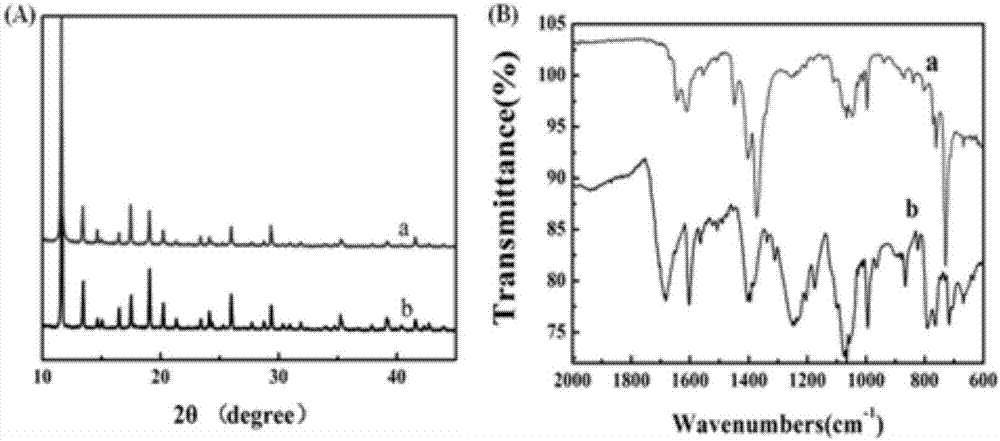ZnTCPP@MOF-based electrochemical immunoassay method for microcystic toxins
A microcystin and immunoassay technology, applied in the field of electrochemical sensing, can solve the problems of low detection limit, narrow linear range and high cost, and achieve the effects of convenient operation, high detection sensitivity and low cost
- Summary
- Abstract
- Description
- Claims
- Application Information
AI Technical Summary
Problems solved by technology
Method used
Image
Examples
Embodiment 1
[0026] The preparation method of porphyrin functionalized metal-organic framework material ZnTCPP@MOF can be obtained by referring to the literature [Porphyrin-Encapsulated Metal-Organic Frameworks as Mimetic Catalysts for Electrochemical DNA Sensing via Allosteric Switch of Hairpin DNA]. The specific steps are as follows:
[0027] (1) 0.5g trimesic acid (H 3 BTC) and 30mg zinc porphyrin (ZnTCPP), added to 15ml 1:1 (V:V) mixture of absolute ethanol and DMF, and then mixed with 7.5ml Cu(NO 3 ) 2 ·3H 2 O (1.04g) aqueous solution was mixed, and the above-mentioned mixed solution was ultrasonicated for 20 minutes to make it fully homogeneously dispersed;
[0028] (2) Divide the mixed liquid into 50ml polytetrafluoroethylene tanks and seal them with a high-pressure reactor, put the reactor into an electric heating constant temperature blast drying oven, heat at 60°C for 7 hours, and then cool to room temperature.
[0029] (3) Centrifuge the cooling mixture in step (2) at a speed...
Embodiment 2
[0032]Dissolve 1 mg, 5 mg, 10 mg, 15 mg and 20 mg of TOAB in 1 mL of 10 mg / mL ZnTCPP@MOF toluene solution, respectively, take 20 μL of the above solution to modify on the glassy carbon electrode, place it to dry at room temperature, and use the platinum wire electrode as the counter electrode , the Ag / AgCl electrode is used as the reference electrode, and the above-mentioned modified electrode is used as the working electrode to contain 0.1M KNO 3 The 0.1M pH7.4PBS is used as the electrolyte, and the ECL signal intensity is detected. Electrochemiluminescence system parameter setting: bias voltage of photomultiplier tube is 1kV, amplification stage is 3, scanning potential range is set to -1.7~-0.5V, and scanning rate is 100mV·s-1. Test results such as Figure 4 As shown in (A), when the amount of TOAB is too small, the stability of ZnTCPP@MOF on the electrode is not enough and it is easy to fall off. When the amount of TOAB is too large, the film of TOAB on the surface of the...
Embodiment 3
[0034] The assembly process of MC-LR electrochemical immunosensor is as follows: Figure 5 As shown, the main steps are as follows:
[0035] 20 μL of 10 mg / mL ZnTCPP@MOF and 10 mg / mL tetraoctylammonium bromide (TOAB) toluene mixed solution was dropped to modify the surface of GCE electrode, and dried naturally at room temperature to prepare ZnTCPP@MOF(TOAB) / GCE electrode; Add 20 μL of a mixed aqueous solution of 400 mM EDC and 100 mM NHS to the ZnTCPP@MOF(TOAB) / GCE electrode dropwise to activate the carboxyl group of the metal-organic framework ZnTCPP@MOF. After reacting at room temperature for 30 minutes, rinse with 0.01M PBS solution of pH 7.4 On the electrode surface, modify 20 μL antigen MC-LR on the electrode, and incubate in a 37°C incubator for 1 hour, then rinse the electrode surface with PBS solution to remove excess MC-LR, and then prepare MC-LR / ZnTCPP@MOF (TOAB) / GCE; Finally, 20 μL of 10 μg / mL anti-MC-LR monoclonal antibody (anti-MC-LR) was added dropwise on the mo...
PUM
 Login to View More
Login to View More Abstract
Description
Claims
Application Information
 Login to View More
Login to View More - R&D
- Intellectual Property
- Life Sciences
- Materials
- Tech Scout
- Unparalleled Data Quality
- Higher Quality Content
- 60% Fewer Hallucinations
Browse by: Latest US Patents, China's latest patents, Technical Efficacy Thesaurus, Application Domain, Technology Topic, Popular Technical Reports.
© 2025 PatSnap. All rights reserved.Legal|Privacy policy|Modern Slavery Act Transparency Statement|Sitemap|About US| Contact US: help@patsnap.com



